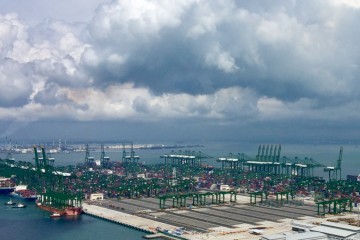Container transport is a colourful business. Metaphorically and literally. The diversity of containers reflects the diversity of container lines: each line has containers with their own colour, name and sometimes – for those who care – a sleek logo. Yet, this coloristic variety hides a long-lasting inefficiency of the containerised supply chain. The time is ripe to solve this.
What is the issue?
Most of the containers that are used in containerised transport belong to individual container lines, so the container cannot be used by another line even if that would make sense from a supply chain perspective. A blue container that is delivered and emptied (unstuffed) can in most cases not be instantly stuffed at the same place when there is no cargo to be transported by that “blue” shipping company, even if there is “red” cargo waiting for a container. The result is a lot of transport movements of empty containers between ports, distribution centres, container depots and warehouses. Good news for truckers, bad news for shippers, as this makes cargo transport more expensive and less smooth. Shipping lines want productive utilisation of their asset – the container – so cannot possibly be happy with this situation either. Not to mention all the air emissions from unnecessary truck movements that could be avoided.
How to avoid it?
The answer is simple: get rid of the colours. Instead of a blue container for a blue ship, develop a “grey container” that could be used by everyone. Put differently, develop a common pool of containers that could be easily exchanged between carriers, forwarders and large shippers. A simple idea, proposed in various forms and at different occasions, but one that has been difficult to implement.
Why the resistance?
First, there is marketing. Animals have colours to impress and attract. The same goes for liners, even if it is dolphins that in practice might be the most frequent admirers of the colourful containers.
Second, a fear for transaction costs. Carriers understandably do not want more red tape than they already have: a common pool administered by a bureaucratic mind might result in exactly that.
Finally, resistance might be linked to corporate strategy. A shipping company that has invested in a lot of containers would not want others to “free-ride” on his investment. Put slightly differently, having a collection of containers could be a barrier of entry for smaller players, so big carriers would not want to give away that advantage.
(As a side-note: there are firms that lease out containers, providing some sort of a common pool, but their revenue model is based on maximising the number of containers, rather than optimising the utilisation of containers, so more container leasing might not actually solve the problem.)
The time is ripe for change
1. More than ever before, this is the time for container lines to be ruthless about productivity and utilisation. The alternative is death. So, is your own colour worth the costs of soccer fields of idle containers?
2. Each line offers the same product anyway, whatever the colour, so why be picky about being blue, red or yellow? Moreover, a lot of differently coloured containers nowadays end up on the same ship, as a result of increased vessel size and alliances. The difference between a blue or yellow container has become an optical illusion. If we accept far-reaching vessel sharing arrangements, would the logical next step not be some sort of container sharing agreements?
3. Containers are becoming less dumb. More and more containers are equipped with devices that make it possible to follow where they are, anticipate how they could be best used and by whom. The data exist to arrange for an exchange platform without heavy administrative burdens.
The momentum is there, waiting for willingness to act. After decades of colour, container shipping is in need of a few shades of grey.
2 Comments
Comments are closed.




Great points! However, I wonder if a use these colors as some kind of system to prioritize shipments
Great points here I would have to agree and develop a few shades of grey!